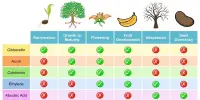Plant taxonomy is the science of discovering, identifying, describing, classifying, and naming plants. It is the science of naming, characterizing, and categorizing plants based on their properties, relationships, and evolutionary history. It is one of the major divisions of taxonomy (the study of discovering, describing, classifying, and naming living things). The study of plants is an important branch of botany.
Plant taxonomy’s major purpose is to classify the great diversity of plant species into a hierarchical system that reflects their evolutionary links and assists researchers, botanists, horticulturists, and conservationists in better understanding and communicating about plant life. It is closely related to plant systematics, with no clear distinction between the two. In reality, “plant systematics” is concerned with links between plants and their evolution, particularly at higher levels, whereas “plant taxonomy” is concerned with the practical handling of plant specimens.
Key components of plant taxonomy include:
- Nomenclature: This entails giving plants scientific names in accordance with the International Code of Nomenclature for Algae, Fungi, and Plants (ICN). Scientific names are made up of a genus name (capital letter) and a species epithet (lowercase letter), often followed by the name of the person who first described the species. Helianthus annuus, for example, is the scientific name for the common sunflower.
- Classification: Plant species are classified into hierarchical categories, which include: kingdom, division (or phylum for some groups like algae), class, order, family, genus, and species, in that order. This hierarchy aids in the classification of plants into groups.
- Identification: Taxonomists recognize and identify plant species based on morphological (physical aspects such as leaves, flowers, and stems), anatomical, genetic, and ecological factors. Modern techniques for plant identification, such as DNA sequencing, have become indispensable.
- Phylogenetics: It is increasingly relying on molecular approaches to investigate the evolutionary links between plant species. Phylogenetic trees, which are built using genetic data, aid in the understanding of plant evolution and relatedness.
- Herbaria: These are collections of preserved plant specimens, such as dried leaves, flowers, and fruits, along with associated data like location and date of collection. Herbaria serve as essential resources for plant taxonomists and researchers.
- Nomenclature Codes: There are several international regulations and protocols that govern plant nomenclature and classification. In addition to the ICN for plants, there are distinct codes for cultivated plants (ICNCP) and cultivated fungi (ICCF).
Plant taxonomy is critical for a variety of applications, including conservation efforts, agriculture, horticulture, medicine (for recognizing medicinal plants), and understanding plant ecology and evolution. It provides a common language for scientists to speak about plants and aids in the organization of knowledge regarding plant variety. As scientific awareness of plant interactions increases, plant taxonomy evolves to reflect our greater grasp of the plant kingdom’s complexity and diversity.
















